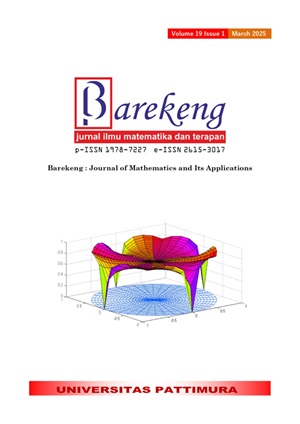THE IMPLEMENTATION OF GEOGRAPHICALLY WEIGHTED REGRESSION (GWR) METHOD ON OPEN UNEMPLOYMENT RATE IN REGENCY/CITY OF SUMATRA ISLAND
Abstract
Unemployment is a condition where a person who is included in the labor force but does not have a job and is not actively looking for work. The number of unemployed is measured using the Open Unemployment Rate (OUR) indicator. OUR is obtained by comparing the number of job seekers and the number of labor force. This study aims to obtain a model of OUR in each district / city of Sumatra Island and what factors influence it using the Geographically Weighted Regression (GWR) method and Fixed Gaussian Kernel Function weighting, and describe predictor variables on thematic maps. The GWR method is one of the statistical methods that can prevent the presence of spatial aspects in the data. The parameters estimated by the local regression model vary at each location point and are estimated using the Weighted Least Square (WLS) method. Based on the research results obtained from this study, the GWR models obtained amounted to 154 different local models in each district / city on the island of Sumatra. Variables Labor Force Participation Rate, Population Growth Rate, Population Density and Average Years of Schooling have a significant influence on each location, meanwhile variable Percentage of Poor Population and variable Poverty Line have no influence on any location. These variables are able to explain the OUR by 57.2%, where the remaining 42.8% is explained by other factors that are not explained in the model.
Downloads
References
N. Lutfiani and dan Scolastika Mariani, “Pemodelan Geographically Weighted Regression (GWR) dengan Fungsi Pembobot Kernel Gaussian dan Bi-square,” UNNES J. Math., vol. 5, no. 1, pp. 82–91, 2017, [Online]. Available: http://journal.unnes.ac.id/sju/index.php/ujmUJM8
C. H. Lin and T. H. Wen, “Using geographically weighted regression (GWR) to explorespatial varying relationships of immature mosquitoes andhuman densities with the incidence of dengue,” Int. J. Environ. Res. Public Health, vol. 8, no. 7, pp. 2798–2815, 2011, doi: 10.3390/ijerph8072798.
T. Sirait, “Overdispersi karena Kesalahan Spesifikasi Model dan Cara Mengatasinya,” vol. 5, no. 1, pp. 695–701, 2014.
T. W. Utami, A. Rohman, and A. Prahutama, “Pemodelan Regresi Berganda Dan Geographically Weighted Regression Pada Tingkat Pengangguran Terbuka Di Jawa Tengah,” Media Stat., vol. 9, no. 2, p. 133, 2017, doi: 10.14710/medstat.9.2.133-147.
R. Putra, S. Wahyuning Tyas, and M. G. Fadhlurrahman, “Geographically Weighted Regression with The Best Kernel Function on Open Unemployment Rate Data in East Java Province,” Enthusiastic Int. J. Appl. Stat. Data Sci., vol. 2, no. 1, pp. 26–36, 2022, doi: 10.20885/enthusiastic.vol2.iss1.art4.
M. R. Ramadayani, Fariani Hermin Indiyah, and Ibnu Hadi, “Pemodelan Geographically Weighted Regression Menggunakan Pembobot Kernel Fixed dan Adaptive pada Kasus Tingkat Pengangguran Terbuka di Indonesia,” JMT J. Mat. dan Terap., vol. 4, no. 1, pp. 51–62, 2022, doi: 10.21009/jmt.4.1.5.
S. P. Agustianto, S. Martha, and N. Satyahadewi, “Pemodelan Faktor Penyebab Kecelakaan Lalu Lintas di Kalimantan Barat dengan Metode Geographically Weighted Regression (GWR),” Bul. Ilm. Math. Stat. dan Ter., vol. 07, no. 4, pp. 303–310, 2018.
B. P. Statistika, “Provinsi Aceh dalam Angka 2022,” 2022. https://aceh.bps.go.id/ (accessed Feb. 11, 2023).
B. P. Statistika, “Provinsi Bengkulu dalam Angka 2022,” 2022. https://bengkulu.bps.go.id/ (accessed Feb. 11, 2023).
B. P. Statistika, “Provinsi Jambi dalam Angka 2022,” 2022. https://jambi.bps.go.id/ (accessed Feb. 11, 2023).
B. P. Statistika, “Provinsi Kepulauan Bangka Belitung dalam Angka 2022,” 2022. https://babel.bps.go.id/ (accessed Feb. 12, 2023).
B. P. Statistika, “Provinsi Kepulauan Riau dalam Angka 2022,” 2022. https://kepri.bps.go.id/ (accessed Feb. 12, 2023).
B. P. Statistika, “Provinsi Lampung dalam Angka 2022,” 2022. https://lampung.bps.go.id/ (accessed Feb. 12, 2023).
B. P. Statistika, “Provinsi Riau dalam Angka 2022,” 2022. https://riau.bps.go.id/ (accessed Feb. 12, 2023).
B. P. Statistika, “Provinsi Sumatera Barat dalam Angka 2022,” 2022. https://sumbar.bps.go.id
B. P. Statistika, “Provinsi Sumatera Selatan dalam Angka 2022,” 2022. https://okikab.bps.go.id/ (accessed Feb. 12, 2023).
B. P. Statistika, “Provinsi Sumatera Utara dalam Angka 2022,” 2022. https://sumut.bps.go.id/ (accessed Feb. 11, 2023).
A. S. Fotheringham, C. Brunsdon, and M. Charlton, Geographically Weighted Regression: The Analysis of Spatially Varying Relationships. J. Wiley & Sons, Eds, 2002.
Derisma, Fridaus, and R. P. Yusya, “Perancangan Ikat Pinggang Elektronik Untuk Tunanetra Menggunakan Mikrokontroller Dan Global Positioning System (GPS) Pada Smartphone Android,” J. Tek. Elektro ITP, vol. 5, no. 2, pp. 130–136, 2016.
J. LeSage and R. K. Pace, Introduction to Spatial Econometrics. Taylor & Francis Group, 2009.
M. Sriningsih, D. Hatidja, and J. D. Prang, “Penanganan Multikolinearitas Dengan Menggunakan Analisis Regresi Komponen Utama Pada Kasus Impor Beras Di Provinsi Sulut,” J. Ilm. Sains, vol. 18, no. 1, p. 18, 2018, doi: 10.35799/jis.18.1.2018.19396.
S. Sukarna, W. Sanusi, and H. Hardiono, “Analisis Moran’s I, Geary’s C, dan Getis-Ord G pada Penerapan Jumlah Penderita Kusta di Kabupaten Gowa,” J. Math. Comput. Stat., vol. 2, no. 2, p. 151, 2020, doi: 10.35580/jmathcos.v2i2.12577.
M. R. Fadli, R. Goejantoro, and Wasono, “Pemodelan Geographically Weighted Regression (GWR) Dengan Fungsi Pembobot Tricube Terhadap Angka Kematian Ibu (AKI) Di Kabupaten Kutai Kartanegara Tahun 2015,” J. Eksponensial, vol. 9, no. 1, pp. 11–18, 2018, [Online]. Available: http://jurnal.fmipa.unmul.ac.id/index.php/exponensial/article/view/209
Copyright (c) 2025 Syarifah Meurah Yuni, T. Murdani Saputra, Nadya Nur Fadhilah

This work is licensed under a Creative Commons Attribution-ShareAlike 4.0 International License.
Authors who publish with this Journal agree to the following terms:
- Author retain copyright and grant the journal right of first publication with the work simultaneously licensed under a creative commons attribution license that allow others to share the work within an acknowledgement of the work’s authorship and initial publication of this journal.
- Authors are able to enter into separate, additional contractual arrangement for the non-exclusive distribution of the journal’s published version of the work (e.g. acknowledgement of its initial publication in this journal).
- Authors are permitted and encouraged to post their work online (e.g. in institutional repositories or on their websites) prior to and during the submission process, as it can lead to productive exchanges, as well as earlier and greater citation of published works.






1.gif)



